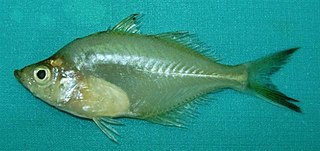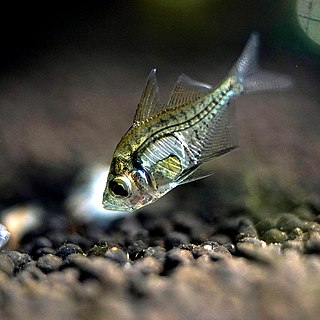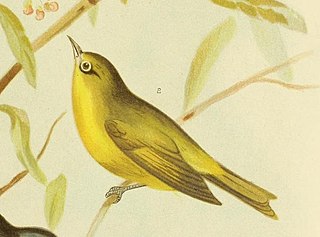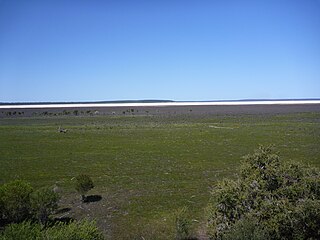
The blue-cheeked bee-eater is a near passerine bird in the bee-eater family, Meropidae. The genus name Merops is Ancient Greek for "bee-eater", and persicus is Latin for "Persian".

The members of the family Percichthyidae are known as the temperate perches. They belong to the order Perciformes, the perch-like fishes.

The elongate glassy perchlet is a species of freshwater fish in the Asiatic glassfish family Ambassidae of order Perciformes, the only species in the genus Chanda. It is native to an area of south Asia from Pakistan to Burma, in the Indomalayan realm.

Parambassis is a genus of freshwater fish in the Asiatic glassfish family Ambassidae of order Perciformes. The type species is the Iridescent glassy perchlet. These fishes originate mostly from Southeast Asia, but the species range across the Indomalayan and Australasian realms, from Pakistan, China and India south through Indonesia, New Guinea and Australia. Although primiarly found in fresh water, a few species can also be seen in brackish water. The Parambassis species range in maximum size from 4–24 cm (1.5–9.5 in), but they are similar in appearance, with a lozenge-shaped form, typical perciform fins, and semitransparent or transparent body. Several of the species are common food fish in local markets, and some are kept as aquarium fish.

The Macquarie perch is an Australian native freshwater fish of the Murray-Darling river system. It is a member of the family Percichthyidae and is closely related to the golden perch.

The climbing perch is a species of amphibious freshwater fish in the family Anabantidae. A labyrinth fish native to Far Eastern Asia, the fish inhabits freshwater systems from Pakistan, India, Bangladesh and Sri Lanka in the west, to Southern China in the east, and to Southeast Asia west of the Wallace Line in the south. It is likely that Anabas testudineus is a species complex, with the binomial name applied to what are actually several different species. With further study, populations of this fish may be divided up into separate species and given new names. In Nepalese Terai it is called "Pothiya". In Bengali it is called "কৈ" (Koi). In Indonesia, it is known by many names, such as betok (Indonesian), běthik (Javanese), and papuyu (Banjarese)

The African black swift, also known as the African swift or black swift, is a medium-sized bird in the swift family. It breeds in Africa discontinuously from Liberia, Cameroon, Zaire, Uganda and Kenya southwards to South Africa. The "black swifts" of Madagascar and the Comoros are either taken as two subspecies of the African black swift, or otherwise deemed a full species, the Malagasy black swift.

The inland broad-nosed bat is a species of vesper bat. They are endemic to Australia and widespread throughout the inland, especially in arid and semi-arid regions. This insectivorous microbat, measuring 12 centimetres (4.7 in) in length, roosts in tree hollows during the day and forages over woodland and water at night.

The northern broad-nosed bat is a species of the vespertilionid family of microbats. It can be found in northern Australia, Timor-Leste, and Papua New Guinea.
The Yarra pygmy perch is a species of temperate perch that is endemic to southeastern Australia.
Nannoperca or pygmy perch is a genus of temperate perches endemic to freshwater systems of Australia.

Nannoperca oxleyana, commonly known as the Oxleyan pygmy perch, is a species of temperate perch endemic to Australia. It occurs in the coastal drainages of eastern Australia, being found in dune lakes, ponds, creeks, and swamps with plentiful vegetation to provide shelter. The waters in which it lives are often dark and acidic. It preys upon aquatic insects and their larvae, as well as planktonic crustaceans and even algae. This species can reach 7.5 cm (3.0 in) SL, though most do not exceed 4 cm (1.6 in). It can also be found in the aquarium trade.
The golden pygmy perch is a species of temperate perch endemic to Australia, where it is found in both Ewens Ponds and Deep Creek, South Australia, and several tributaries of the Glenelg River in Victoria. It prefers flowing water of ponds or small streams, generally being more commonly found in the streams that connect to the ponds, with plentiful vegetation or debris to provide shelter. It preys on extremely small crustaceans and aquatic insects. This species can reach 6.5 cm (2.6 in) SL. It can also be found in the aquarium trade.

The canary white-eye or yellow white-eye is a species of white-eye endemic to northern Australia in subtropical or tropical mangrove forests. Its common name reflects the circle of white feathers around its eye.

Agassiz's perchlet, also known as Agassiz's glass fish and the olive perchlet, is a species of ray-finned fish in the family Ambassidae. It is semi-transparent with dark scale edges forming a pattern over most of the body. It grows to a maximum of 7.5 cm. It is a macrophyte spawner with adhesive eggs. It is endemic to Australia. It was named for the zoologist Louis Agassiz.

The coppercheek darter is a species of freshwater ray-finned fish, a darter from the subfamily Etheostomatinae, part of the family Percidae, which also contains the perches, ruffes and pikeperches. It is endemic to the southeastern United States. It is only known from the Duck River system of Tennessee. It is an inhabitant of small and medium rivers where it occurs in rocky riffles with clear, fast-flowing water. It preys on insect larvae and other immature stages and is also known to consume snails. This species can reach a length of 8 cm (3.1 in), though most only reach about 5.6 cm (2.2 in).

The Rio Grande darter is a small species of ray-finned fish, a darter from the subfamily Etheostomatinae, part of the family Percidae which includes the perches, ruffs and pike-perches. It is endemic to the lower Rio Grande drainage of the United States and Mexico. It inhabits riffles over substrates of gravel or rubble. This species can reach a length of 6 cm (2.4 in), though most only reach about 3 cm (1.2 in). The Rio Grande darter was first formally described as Oligocephalus grahami in 1859 by the French zoologist Charles Frédéric Girard (1822-1895) with the type locality given as the Devils River in Texas. The specific name honors the American soldier and topographer James Duncan Graham (1795-1865), who led the expedition on which the type was collected by John H. Clark.

Parambassis pulcinella, the humphead glassfish or humphead perchlet, is a species of Asiatic glassfish native to fast-flowing streams in the Ataran basin in southeast Myanmar and west Thailand. It reaches a length of 10 cm (3.9 in) and is sometimes seen in the aquarium trade. It is a relative of the perch.

Lake Muir Nature Reserve is a protected area in Western Australia. It encompasses Lake Muir and several smaller lakes and wetlands. It is an important refuge for water birds, and home to several rare plants and plant communities.

Plectranthias nanus, also known as brownband perchlet and dwarf perchlet, is a species of fish in the family Serranidae occurring in the Pacific Ocean.


















